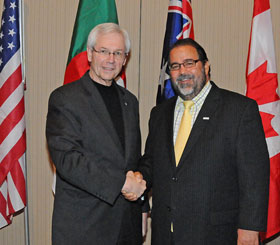UC Riverside’s Center for Environmental Research and Technology (CE-CERT) is launching its new Transportation Fuels Research Center of Excellence. The Center was created with a $1.2 million grant from the California Energy Commission and the goal of the research and education facility will be to work on characterizing the emissions and performance of new alternative fuels. In addition, the center will ensure that new fuels will not have adverse environmental or health impacts.
![durbin[1]](http://energy.agwired.com/wp-content/uploads/sites/11/2010/10/durbin1.jpg) “We are leaders in characterizing vehicle emissions and the consequences of those emissions,” said Tom Durbin, a research engineer at CE-CERT. “The establishment of this center and this grant allow us to continue and expand that work.”
“We are leaders in characterizing vehicle emissions and the consequences of those emissions,” said Tom Durbin, a research engineer at CE-CERT. “The establishment of this center and this grant allow us to continue and expand that work.”
The grant will allow the center to expand its studies on butanol, butanol/ethanol combination, and other mixed fuel combinations. They also want to learn how these fuels impact vehicle performance and emissions and understand their compatibility with different engine technologies.
To celebrate the center’s opening, UC Riverside is hosting a series of free community events on Oct. 14, 2010. The day will kick off with a National Alternative Fuel Vehicle Day mini-workshop to help attendees develop a basic understanding of alternative fuels and new technologies. This workshop is one of nearly 125 nationwide that are being coordinated by the National Alternative Fuels Training Consortium at West Virginia University. Following the workshop attendees will be able to view a collection of alternative fuels vehicles in the CE-CERT parking lot.
At 2 p.m., the USDA’s Draft Biofuels Strategic Production Report, which outlines how the biofuels industry can serve as a strong economic regional strategy to help recharge the rural American economy, will be outlined for public comment. Topics to be discussed include potential sources of feedstock, the current local infrastructure to support biofuels, and the estimated land use needed in California for biofuels.
During the session, comments will also be sought on how state and/or federal agencies can more effectively partner with the private sector and will also address developing nationwide infrastructure for alternative fuels.










